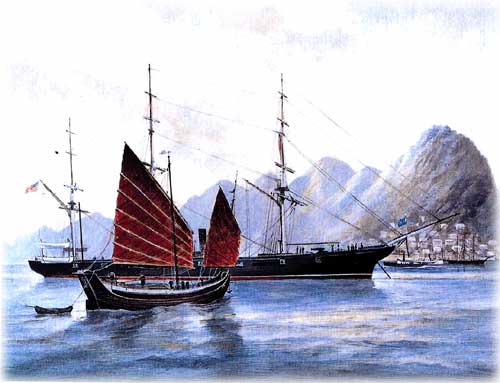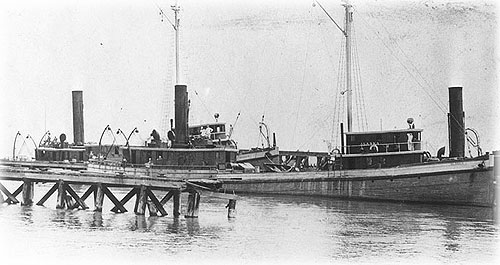 By DAVE KIFFER June 18, 2008
The first US naval vessel named after Alaska was a "sloop of war" built at the Boston Naval Shipyards in 1868, just a year after America purchased Alaska from Russia. According to Boston shipyard records, the 250-foot "steam screw" sloop was 2,400 tons and had an armament of one 11-inch smooth bore cannon and six 8-inch cannons. It also had a single 60-pound rifled gun. The sloop was launched on October 31, 1868 and was sponsored by Grace Hull, daughter of the mayor of Boston, according to the US Navy historical center. Commander Homer C. Blake was in command when the ship was commissioned on Dec. 8, 1869.  Photo is copied from a print owned by Dave Kiffer The original painting sells for $7,500 and can be purchased from ArtsWorksOriginals.com
The Alaska and four other ships - Colorado, Moncracy, Benecia and the Palos - left Nagasaki, Japan on May 16 a sailed to the mouth of the Salee River near Seoul. The official mission of the fleet was to secure a treaty with the Koreans regarding the treatment of shipwrecked foreigners. Five years previously, the American merchant marine ship, General Sherman, had attempted to begin trade with the Koreans. A dispute had erupted and the crew of the ship was killed. It had been just over a decade and a half since the US Navy had successfully "opened up" Japan to the West, and Naval officials expected a "show of force" would have similar result in Korea, according to the Naval History center. When the fleet reached the mouth of the Salee, it was clear that the larger ships could not proceed further because of the shallows. Commander Blake of the Alaska was placed in charge of a surveying expedition that involved the Palos, Monocracy and steam launches from the three larger ships. According to the "Letters of Homer Crane Blake" at the University of Notre Dame, the surveying expedition spent four days trying to find a useable "channel" up the river for the larger vessels, then returned to main fleet. During that time, a group of Koreans approached the main fleet - under the command of Rear Admiral John Rodgers - to apparently ascertain the fleet's intentions. According to Crane's letters, there was apparent translation confusion between the fleet officers and the Korean emissaries. Eventually, Rodgers informed the Koreans that the survey would continue. The Koreans left and Blake was sent on a second mission with his survey boats. When it came to a line of forts approximately 10 miles up the river, the survey boats were fired upon and two sailors were wounded. The launches returned to the mouth of the river and Rodgers waited 10 days for an "apology" from the Koreans, according to Blake. Rodgers decided to take to the forts by force and dispatched the steam launches and an invasion force of some 651 sailors and marines. A short way up the river, the force met a Korean junk bearing a message that was neither one of peace or apology, according to Blake, so the flotilla continued on to the line of forts. It immediately began bombarding the first fort and was fired on by the two other forts. "The landing force under Com. Kimberly was now dispatched but experienced great difficulty in effecting a landing on account of the mud flats which lined the shore," Blake wrote. "The many men engaged in landing the howitzers sank up to their thighs in the soft but tenacious clay, losing shoes, leggings and even trouser legs while the howitzers themselves sank up to the axels." Despite the difficulties in the mud flats, the force secured a beach head. The next day it attacked the first fort and found it deserted. The force then moved ahead until it faced a force, estimated by Blake, at 4,000 to 5,000 Koreans. Heavy fire from the American ships convinced the Koreans to abandon the second fort, leaving the largest fort still heavily defended. The US ships and the dozen shore-based howitzers pounded the final fort for several hours leading up to a charge of the walls by a force of 350 sailors and marines. The hand-to-hand battle was over in less than three hours. Korean casualties were estimated at more than 350 killed. US loses were three killed, included USS Alaska Marine Lt. Hugh A. McKee who was the first to scale the walls, seize a Korean flag before he was stabbed and shot and was awarded the Congressional Medal of Honor for his bravery. Although the US forces were now very close to Seoul, they decided to hold their positions and wait for a response from the Koreans. The Koreans did nothing and the Americans waited at the forts for nearly a month. Finally, when it became obvious the Koreans weren't going to respond Rodgers ordered the fleet to abandon the forts and return to Japan. The Alaska returned to its station with the Asiatic Squadron. The USS Alaska remained in Asian until October 28, 1872 when it left for New York and refurbishing. On August 28, 1873 it was sent to the European Squadron and served in Spain for two months before being sent to Cuba where the US was concerned about Spains attempts to put down a rebellion. Eight US citizens had been caught up in the rebel cause and executed by the Spanish, which generated a large outcry in the US. Naval officials sent the Alaska and other ships to Key West, Florida in anticipation that war would break out. War did not break out, however, and by April of 1874, the Alaska was back on patrol in the Mediterranean Sea. In 1876, she returned to New York and was decommissioned while undergoing extensive repairs. She was recommissioned in 1878, and then sent around Cape Horn to visit ports on the west coast of South America. It was in Callao, Peru that a second member of the crew would win a Congressional Medal of Honor. Fireman Second Class Edward Barrett, was given the award when "following the rupture of the stop-valve chamber, Barrett courageously hauled the fires from under the boiler of that vessel," according to his award certificate. Shortly afterwards, the USS Alaska made its only known visit to its namesake. "On March 22, 1879, she got underway for Sitka, Alaska, where Indian unrest endangered the lives and property of American citizens," according to the Naval History center. "She arrived at Sitka on April 3 and - except for a voyage to Victoria, British Columbia, late in April - she served there until June 16." The USS Alaska was then based in San Francisco until 1883. During that time, she made several trips to South America, the South Pacific and even Hawaii. In 1883, a marine survey determined the ship was at the end of its useful sea life. It was decommissioned on Feb. 13, 1883 and sold for scrap at Mare Island in November, 1883.
USS Alaska 2 - Minesweeper Very little is known about the second USS Alaska.  Served as USS Alaska (ID # 3035) in 1918-1919 Photo courtesy U.S. DEPARTMENT OF THE NAVY -- NAVAL HISTORICAL CENTER
Editor's Note:
On the Web:
Dave Kiffer is a freelance writer living in Ketchikan, Alaska. To republish this article, the author requires a publication fee. Contact Dave at dave@sitnews.us
|